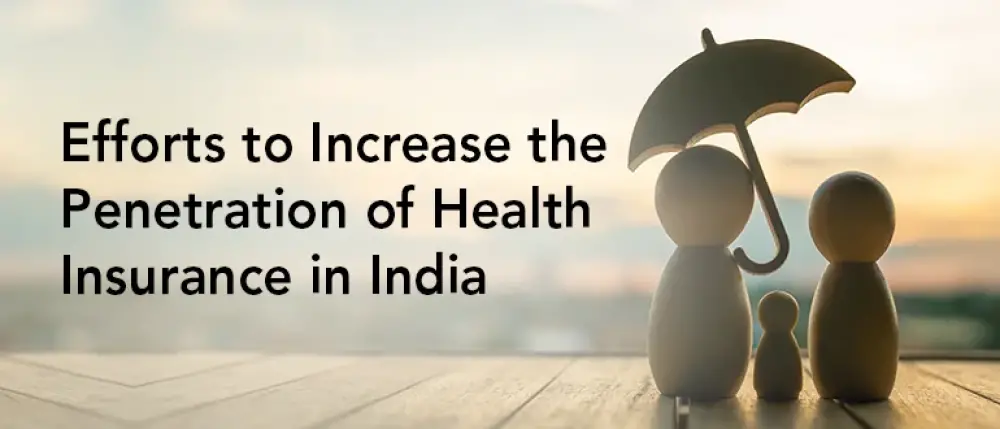Subscribe to get weekly insights
Always stay up to date with our newest articles sent direct to your inbox
Published on 8 Aug, 2024
Updated on 30 Dec, 2024
1284 Views
3 min Read

Written by Riya Lohia
1Like
According to a National Insurance Academy (NIA) report, 31% of India’s population still lacks health insurance. Several factors contribute to this protection gap, such as low health insurance penetration, insufficient coverage, rising medical costs, lack of understanding of insurance products, and high costs. Since health insurance is a crucial aspect of financial security for families and essential for a robust healthcare ecosystem, there is a need to bridge the protection gap. IRDAI, and the government are taking many initiatives to improve the health insurance penetration in India.
In this blog, we will discuss the efforts to increase the penetration of health insurance in India.
According to IRDAI, the health insurance market in India is expected to become the sixth-largest insurance market in the world within a decade. However, health insurance penetration in India is still lower than expected. The upcoming regulatory developments and reforms are being designed and executed not just to contribute to the market's growth but also for better inclusivity.
Here are some key strategies IRDAI and the government have adopted to increase medical insurance penetration in India.
Less than 20% of the rural population currently has health insurance coverage despite government schemes and mandatory health insurance coverage. However, with increasing internet usage and the growing popularity of microfinance institutions in rural areas, you can expect better accessibility of health insurance coverage to the rural public. IRDAI’s proposed initiatives like Bima Vahak to support rural women and Bima Vistaar for comprehensive life, health and property coverage aim to improve rural inclusion.
Insurers are now combining traditional distribution models with digitally enabled distribution channels for better reach and lower operational costs. This also helps remove any friction and makes the whole process more flexible. Many consumers today prefer to explore and compare different products online and use automated processes for faster access. They also like to have a human connection if they have a query or want to raise a claim.
Insurers no longer offer just a defined set of products, they are now flexible enough to customise a product to match the needs of a specific customer segment, such as a particular age group, gender, occupation, etc. Insurers also provide value-added services beyond health care coverage that include prevention to encourage customers to stay healthy and fit to save future hospitalisation costs.
Marketing is now considered an investment rather than an expenditure. Insurers use advanced marketing technology to target consumers, employing tools such as social media, search history, personalised content, and affiliate marketing for targeted engagement and lead generation. Agents filter these leads using analytics to facilitate customer conversion.
The General Insurance Council is about to launch the “Cashless Everywhere” initiative, which allows policyholders to receive cashless treatment even at hospitals not part of the insurer's network, subject to terms and conditions. This initiative will encourage more people to get health insurance coverage, especially in rural areas with limited access to network hospitals.
Innovative products designed to meet specific needs can help increase health insurance penetration in India. For instance, long-term health insurance linked to a savings scheme can be a good product to encourage youngsters and women to invest in health insurance coverage. Tax relief on premiums will help reduce the tax load on low-income groups, unorganised workers, and retired individuals. It will also encourage more people to buy health insurance.
National Health Claim Exchange (NHCX) is a unified portal launched to process health insurance claims across all hospitals in the country. It will be a common portal for all 50 insurance companies and speed up the claim process.
IRDAI's vision is to achieve “Insurance for all” by 2047. It proposes to launch universal insurance coverage that encompasses health insurance, life insurance, and property insurance under one plan. This will make it convenient for all stakeholders to manage one policy instead of maintaining separate policies for separate requirements.
>> Also Read: 7-Step Guide to Fill Health Insurance Reimbursement Form
The health insurance industry has been addressing the challenge of low health insurance penetration through various reforms and initiatives. Insurers, regulators, the government, and insurance firms are collaborating to offer comprehensive health insurance solutions to all Indian citizens.
Care Health Insurance provides appropriate health insurance coverage for various medical needs. Visit our website to explore our plans and value-added services, or contact us for a personalised health insurance plan.
Disclaimers: All plan features, benefits, coverage, and claims underwriting are subject to policy terms and conditions. Kindly refer to the brochure, sales prospectus, and policy documents carefully.
How to Download Care Health Insurance Policy? Care Health Insurance in Health
How to Check the Status of Your Health Insurance Policy? Care Health Insurance in Health
What is the Use of ABHA Health Card? Care Health Insurance in Health
Do Health Insurance Premiums Increase Every Year? Care Health Insurance in Health
Why Group Medical Insurance is Important for Employees? Care Health Insurance in Health
Understanding Telemedicine Health Insurance- A Comprehensive Guide Care Health Insurance in Health
What are Teleconsultation and TeleHealth Insurance? Care Health Insurance in Health
How Can Advancements in Technology Impact The Future of Health Insurance? Care Health Insurance in Health